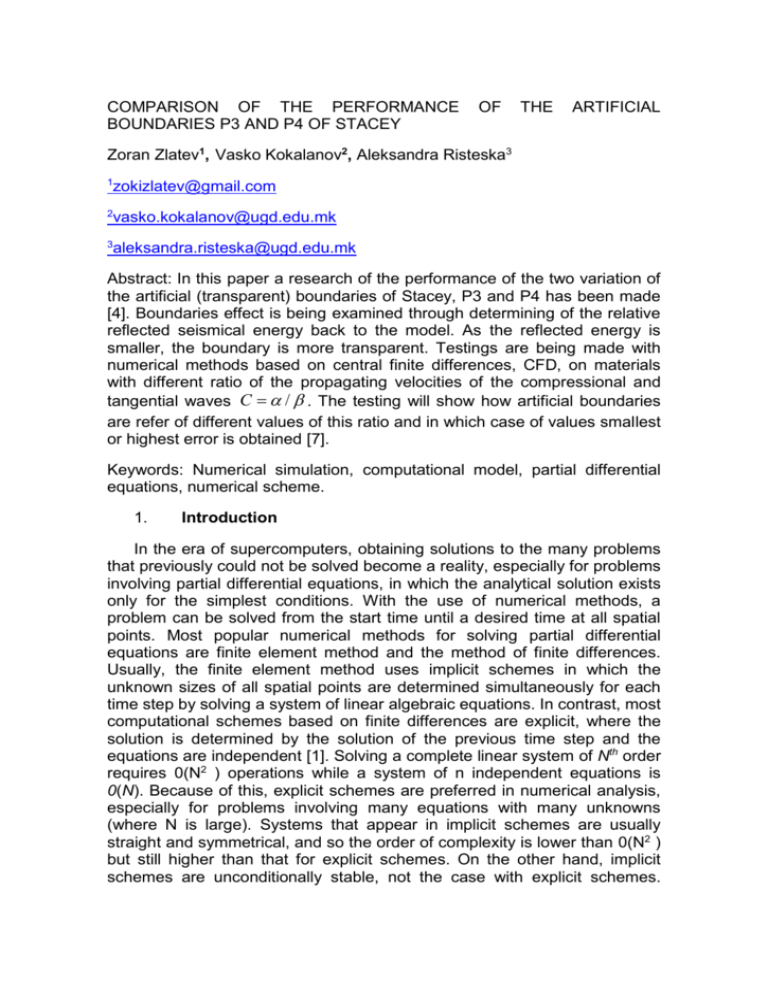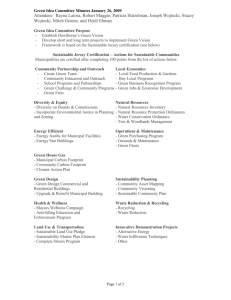finite equations
advertisement

COMPARISON OF THE PERFORMANCE BOUNDARIES P3 AND P4 OF STACEY OF THE ARTIFICIAL Zoran Zlatev1, Vasko Kokalanov2, Aleksandra Risteska3 1 zokizlatev@gmail.com 2 vasko.kokalanov@ugd.edu.mk 3 aleksandra.risteska@ugd.edu.mk Abstract: In this paper a research of the performance of the two variation of the artificial (transparent) boundaries of Stacey, P3 and P4 has been made [4]. Boundaries effect is being examined through determining of the relative reflected seismical energy back to the model. As the reflected energy is smaller, the boundary is more transparent. Testings are being made with numerical methods based on central finite differences, CFD, on materials with different ratio of the propagating velocities of the compressional and tangential waves C / . The testing will show how artificial boundaries are refer of different values of this ratio and in which case of values smallest or highest error is obtained [7]. Keywords: Numerical simulation, computational model, partial differential equations, numerical scheme. 1. Introduction In the era of supercomputers, obtaining solutions to the many problems that previously could not be solved become a reality, especially for problems involving partial differential equations, in which the analytical solution exists only for the simplest conditions. With the use of numerical methods, a problem can be solved from the start time until a desired time at all spatial points. Most popular numerical methods for solving partial differential equations are finite element method and the method of finite differences. Usually, the finite element method uses implicit schemes in which the unknown sizes of all spatial points are determined simultaneously for each time step by solving a system of linear algebraic equations. In contrast, most computational schemes based on finite differences are explicit, where the solution is determined by the solution of the previous time step and the equations are independent [1]. Solving a complete linear system of Nth order requires 0(N2 ) operations while a system of n independent equations is 0(N). Because of this, explicit schemes are preferred in numerical analysis, especially for problems involving many equations with many unknowns (where N is large). Systems that appear in implicit schemes are usually straight and symmetrical, and so the order of complexity is lower than 0(N2 ) but still higher than that for explicit schemes. On the other hand, implicit schemes are unconditionally stable, not the case with explicit schemes. Furthermore, the final elements as numerical tool are more useful than final differences for modeling complex and irregular geometries. However, for problems of large scale [2], that arise in seismology for example, explicit schemes are recommended because they are cheaper (require less computer resources) and are easier to implement in numerical algorithms. In the last few decades, with the rapid development of computing machines, researchers studying wave phenomena using computer simulations of mathematical models. With these simulations can predict how the facility will respond to seismic impulses. This means to determine which locations of the building will have a concentration of voltages and large permanent deformations that may lead to the crashing of the object. Besides vulnerability of the objects, computer simulations of mathematical models help us to study the damage on the ground. Some of the most important challenges that arise in the numerical simulations of the spread of waves: 2. Modeling artificial boundaries Modeling of the free surfaces Modeling of contact between two or more different media Modeling of nonlinear model Structure of Paper Artificial (absorbing transparent) boundaries are artifacts that serve as tend to simulate the entry of the wave in the model and its going out of the model. In this paper, the effect of the artificial boundaries we evaluate according reflected (parasitic) energy from wave that leaves the model. The smaller this reflected energy, the border is better (more transparent). In the field of artificial boundaries in the numerical methods have worked more researchers [3]. According to the formulation of local artificial boundaries are divided into three types: - paraxial extrapolated multidirectional Representative of the first group boundaries is the boundary of Robert Clayton and Bjorn Engquist. They worked on getting and implementation paraksijalni artificial limits on SH and PSV waves. Furthermore, modification and improvement of these boundaries was made by Stacey [4]. Liao and Wong [6], provide a new approach in the execution and implementation of artificial boundaries in the numerical models through extrapolated formulation. Higdon [5] proposes and implements multidirectional formulation of artificial boundaries. Despite the artificial boundaries challenge in numerical modeling of wave propagation is modeling of the free surface. More researchers have investigated the causes of errors in approximation of the free surface. Dominant unstable mode, can often be determined explicitly (Stacey [4]). So using this approach may be proved that the approximation of Ilan (1975) is unstable if 𝛼 > √3 ∙ 𝛽 (1) In this paper we study the performance of two proposed variants of the artificial boundaries Stacey [4] for different ranges of the ratio of propagation velocities compressional P waves, 𝛼, and tangential SV seismic waves, 𝛽. For the most part of the materials the ratio between 𝛼 and 𝛽 lies between 1.59 (quartz) and 2.42 (nobium). For example,for steel 𝛼/𝛽 is 1.83, aluminum is about 2.05. In this paper the stability of the artificial boundaries of Stacey was investigated for values of 𝛼/𝛽 in this range, and also for much smaller and much larger values. Stacey proves that the approximation of the free surface inevitably leads to numerical instabilities of the numerical scheme. But these instabilities have a very slight increase. They become significant only for very long computer tests, and for many practical uses them quite satisfactory. Parallel to the research of artificial boundaries, performed research and improving the accuracy of numerical schemes which approximated partial differential equations in the interior of the computational domain. In this paper, we use an explicit scheme of Kelly [5]. This is an explicit scheme with second-order accuracy both in time and in space 𝑂(∆𝑡 2 , ∆𝑥 2 ). We study Stacey boundaries P3 and P4 for ratios 𝐶 = 𝛼/𝛽 in range 1.5 < 𝐶 < 7 [7]. On the pictures 2a, 3a and 4a are presented the energy generated in the model of the effects of the explosion (input power) and energy out of the model with the propagation of the wave (output energy). When artificial boundaries would have been ideally transparent, because conservativity of the energy, at the end of the analysis, input and power output should be equal. The picture 2a) graphically 𝛼 presented input and output energy ratio 𝐶 = 𝛽 = 1.5. Moreover vertical – axis time is represented in seconds and the ordinate is represented energy (MJ). This image refers to P3 boundary of Stacey. On the picture 2b) graph 𝛼 refers to the same energy and the same ratio between 𝛽 but this picture refers to P4 [4] boundary Stacey. This picture shows that the energy input and output differ significantly, suggesting that C = 1.5, P4 Stacey border is not transparent as opposed to the same case in the picture 2a) or Stacey P3. Pictures 3a) and 3b) can already be seen that the energies are close with the difference that in the picture 3a) Stacey P3 they begin to split and error begins to grow slowly. In the picture 4a) both energies begin to separate significantly while in the picture 4b) they begin to approach that sees the difference between the algorithms is Stacey Stacey P3 and P4. 𝛼 And Stacey among Stacey P3 and P4 with increasing interval in 𝛽 it will grow error and if we go to the values for c = 6,5 and higher system will appear very large errors [7]. Tests were made as Stacey P3 for two seconds and Stacey P4 for two seconds and would present only difference in errors 𝛼 compared to the increase of the ratio 𝛽. In picture 5 with the full line is designated algorithm Stacey P4 and with dashed line Stacey P3 and this is the error that occurs in both algorithms for a period of one second and thus notes that at the same time the error starts to increase, while in picture 6 are presented mistakes for interval of 2 seconds, and notes that many before the error starts to grow. 3. Additional Informatioin 3.1. Pictures Picture 1a: Soil stretch that includes a source of explosion, free surfaces and three artificial boundaries 0.60 Ur(m) 0.50 0.40 0.30 A 0.20 0.10 - 0.020 td 0.040 0.060 t(s) <--------------------------------------------------------------------> Picture 1b: Explosion source approximated polusinusoiden pulse with amplitude A = 0.5 m and duration td = 0,05 s Е(МЈ) 120.00 100.00 80.00 60.00 C=1,5 40.00 20.00 t(s) 1.0 0.9 0.8 0.7 0.6 0.5 0.4 0.3 0.2 0.1 0.0 0.00 Picture 2a: Stacey P3, the dotted line represents the input power, the full line represents the power output in the ratio c = 1,5 in 𝛼/𝛽 Е(МЈ) t(s) 1.0 0.9 0.8 0.7 0.6 0.5 0.4 0.3 0.2 0.1 C=1,5 0.0 120.00 100.00 80.00 60.00 40.00 20.00 0.00 Picture 2b: Stacey P4, the dotted line represents the input power, the full line represents the power output in the ratio c = 1,5 in 𝛼/𝛽 Е(МЈ) 1.0 0.9 0.8 0.7 0.6 0.5 0.4 0.3 0.2 0.1 C=2,0 0.0 140.00 120.00 100.00 80.00 60.00 40.00 20.00 0.00 t(s) Picture 3a: Stacey P3, the dotted line represents the input power, the full line represents the power output in the ratio c = 2,0 in 𝛼/𝛽 120.00 Е(МЈ) 100.00 80.00 60.00 C=2,0 40.00 20.00 1.0 0.9 0.8 0.7 0.6 0.5 0.4 0.3 0.2 0.1 0.0 0.00 t(s) Picture 3b: Stacey P4, the dotted line represents the input power, the full line represents the power output in the ratio c = 2,0 in 𝛼/𝛽 Е(МЈ) 1. 0 0. 9 0. 8 0. 7 0. 6 0. 5 0. 4 0. 3 0. 2 0. 1 C=2,5 0. 0 140.00 120.00 100.00 80.00 60.00 40.00 20.00 0.00 t(s) Picture 4a: Stacey P3, the dotted line represents the input power, the full line represents the power output in the ratio c = 2,5 in 𝛼/𝛽 120.00 Е(МЈ) 100.00 80.00 C=2,5 60.00 40.00 20.00 1.0 0.9 0.8 0.7 0.6 0.5 0.4 0.3 0.2 0.1 0.0 0.00 t(s) Picture 4b: Stacey P4, the dotted line represents the input power, the full line represents the power output in the ratio c = 2,5 in 𝛼/𝛽 Error Comparison of errors at one second P4/P3 30.00% -20.00% 0.0 1.0 2.0 3.0 4.0 5.0 6.0 7.0 8.0 C -70.00% -120.00% -170.00% Picture 5: The full line represents the error in Stacey P4 while dotted is error in Stacey P3 Comparison of errors at two seconds P4/P3 Error 50.00% 0.00% 0.0 1.0 2.0 3.0 4.0 5.0 6.0 C 7.0 -50.00% -100.00% -150.00% Picture 6: The full line represents the error in Stacey P4 while dotted is error in Stacey P3 4. Conclusion The stability and the accuracy of this border is of great importance, although there is many other boundary conditions. To say wich boundary condition is the best you need do make very large analysis and examinations about particular problem. In this paper has been found that between P3 and P4 boundary conditions of Stacey, P3 is better and more stable model. From the results obtained in this paper can be concluded that the stability interval is present betweeen ratio of the velocities of the tangential and compresional waves from 1.5 to 2.5. Thereby calculations are made for larger intervals, which indicates to which values of C P3 and P4 are stable. For real materials, 1.5 <C <2.5, P3 is more accurate than P4. The goal is to make better calculations that will be followed with more accurate applications for exploring the natural dislocations of the earth core. 5. References [1] D.M. Boore (2003): Simulation of ground motion using the stochastic method, Pure and Applied Geophysics, 160, 635-676. [2] K.R. Kelly, R.W. Ward, S. Treitel, R.M. Alford (February 1976): Synthetic Seismograms: A fiite difference approach, Geophysics Vol. 41, No. 1, pp 2-27. [3] N. Dai, A. Vafidis, E. Kanasewich (February 1994): Composite Absorbing Boundaries for the Numerical Simulation of Seismic Waves, Bulletin of the seismological society of America, Vol. 84, No. 1, pp 185191. [4] R. B. Stacey “New Finite – Difference Methods for free surfaces with a stability analysis,” Bulletin of the Seismological Society of America, vol. 84, No. 1, pp 171-184, February 1994. [5] R.L.Higdon “Absorbing Boundary Conditions for elastic waves,” Geopysics, vol. 56, No. 2, pp. 231-241, February 1991. [6] ZP. Liao & H.L. Wong “A Transmitting Boundary for the numerical simulation of elastic wave propagation,” in Soil Dynamics and Earthquake Engineering 3, 1984, 174-183 [7] Z. Zlatev (2012): Numerical simulation of seismic waves propagation generated by explosions. Masters thesis, University Goce Delcev- Stip.





